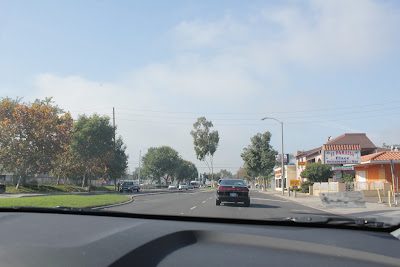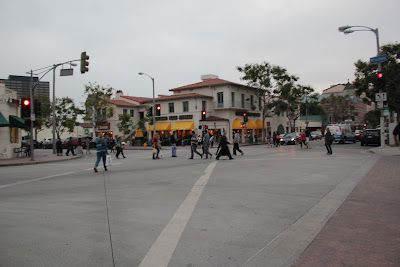[Update: 11/30/2012 All New Additions are Underlined!]
This Trip Includes:
1. A Bus Trip
This week, I took the Big Blue Bus (
Route 1) to Santa Monica! I had never been before, so this was a very exciting and interesting trip. Below is two pictures of me on the bus, leaving the UCLA Ackerman Turnaround on my way to Santa Monica. You can tell I'm pretty psyched for Santa Monica! :D


When I first got on the big blue bus, it was pretty empty and mainly college students from UCLA going to different locations throughout L.A. for leisure. However, by the end of the bus ride, the bus was pretty packed, with some people standing and a diverse group of people, ranging in age, ethnicity, gender and reasons for riding the bus (some were getting groceries or going shopping, others were dressed in business suits going to work or coming back from work, some were going to the doctor, others were doing laundry, etc.). Riding on the bus through Santa Monica, I did notice there were about 10-15 different types of car dealerships, all for expensive cars like BMW, Fisker, Chrysler, etc. which made me think that Santa Monica must be a wealthy area.
In about an hour and a half, I arrived in Santa Monica (stop: Third Street Promenade). As soon as I stepped out of the bus, I could tell this whole area was very busy and lively, with lot so music, people walking around and shopping. The first place I saw was Santa Monica Place, a very huge mall with very high end stores. It wasn't as busy as the surrounding area, but it had numerous christmas decorations and multiple levels with an overwhelming amount of stores. (Pictures Below, 1st picture: I just got off bus and took a picture in front of a dinosaur statue at the Promenade, 2nd & 3rd pictures: Santa Monica Place Mall with Christmas Decorations).



The Santa Monica Place also had lots of signs that had different languages, probably catering to the tourist population coming to Santa Monica (see picture of the "Thank You for Visiting" sign). This sign also suggests that the mall wants to attract an international clientele. There was also a currency exchange station in the middle of the mall, further catering to and desiring to attract an international consumer base. The extravagant christmas decorations also serve as cultural markers that show this mall is more upscale and is a more expensive place to shop. For example, the stores in this mall were almost all designer brands, like Louis Vuitton, Coach, Juicy Couture (storefront below), Nordstroms, etc. This upscale projection can really make some people feel unwelcome in some of the stores or at least feel as if there is no purpose to go into the stores, if they cannot afford it. I also saw a few homeless people walking through this mall, but not as many as throughout the rest of Santa Monica, and they didn't seem to stay in the mall, they just seemed to be walking through it to get to another destination.



Across the street, things were much louder and livelier. There were tons of stores, both high-end and not so expensive with many street performers (many of them children) performing for money to be placed in their buckets. I took a few videos, because they really were amazing (look below)! These children also had their parents with them, although I saw one kid doing a yo-yo performance, where there were no parents to be seen. I'm not sure if these kids just did it for extra cash and for fun, but I think it might have also been because they might have needed the money. However, the equipment they used looked fairly pricey, so perhaps this was just a hobby for them. The kids seemed to make a lot of money, as so many people walking by were impressed by their talent levels for such young ages.
For some reason, the videos above aren't working on this blog, so I have uploaded the videos onto youtube. Here is the link to see all my videos (ones from above): http://www.youtube.com/watch?v=XdrI00v_gbA Make sure to watch them in 1080p (HD)!
The girl in the video with her little sister sounded like
Adele! And woah, I was so blown away by the kid who was drumming to a Beatles song! Contrasting with the kids who were getting lots of money and attention, there were many older homeless men and women who tried to get money, but were not as successful, one homeless man had his dog (also homeless) lie on his back exposing his belly, while people were putting money on top of him, he asked for a $10 donation to take pictures or to pet the dog. Although there were tons of stores on both sides of the street, many people were either window shopping or walking with their families here, only a handful of people I saw actually had bags in their hands from shopping. Many people would just stop to look at the entertainment and then grab something to eat, instead of buying retail items.
After walking around for a bit (and shopping a bit at
LUSH-- they have amazing handmade, cruelty-free, mostly paraben free soaps, lotions and cosmetics that are usually in environmentally friendly packaging), I went to the pier and beach area. Here is where I definitely noticed that there were many homeless people living on the beach, many without shoes. On the sidewalk right before we got to the beach, I noticed one man had such dirty and torn shoes that his back heels were not covered. He slept directly on the concrete, without a blanket or anything. I was very concerned and wondered how he was able to stay warm at night. In this photo I took (below), you can see many homeless people are resting (on benches, on the grass or on the sand).

It is quite interesting to see how Santa Monica attracts both the wealthy, who can afford the expensive stores and homes, and also the poor who can barely afford to buy new shoes or food. For the homeless people, I think the choice in location by the ocean is more of a practical choice of where to live, as the areas by the ocean are not going to get as cold as night as other places in the city because of the moderating influence of the ocean (due to water's high specific heat), also in an economic way, the more tourists and wealthy people there are here, the more likely they are to get money if they need it than if they were to stay in a very poor area. For wealthy people, I think they are attracted to this area because it is by "nature," as we discussed in this week's lecture and living by the coast is not only beautiful, but also symbolizes being able to afford getting away from the concrete jungle of L.A., in other words, a nice status symbol and also being able to find solace in nature (Wilford 2012). Although it is still very urban around the ocean, the proximity of living here make the ocean a nice getaway. You can see these expensive beach homes, in the picture below behind where I am standing.

[Added New Picture Below & Update on Picture 12/1/2012]

Lastly, when I was in Santa Monica, I also noticed this sign near the pier. The sign said "SMURFF", which stands for "Santa Monica Urban Runoff Recycling Facility" (National League of Cities 2012). In Santa Monica, apparently, there is this water filter that filters out the runoff from Santa Monica's streets before they hit the beach. This type of solution would probably be considered part of the "end-of pipe solutions", or a solution that deals with environmental issues and concerns after they have already occurred (Harvey 1999). These type of solutions are common within the "Standard View of Environmental Management", which is when a government or society puts greater importance on economic development and economic health, rather than the environment (Harvey 1999). According to the SMURFF website, the urban runoff water in Santa Monica becomes contaminated by "excess irrigation, spills, construction sites, pool draining, car washing, washing down paved areas and residual wet weather runoff" (National League of Cities 2012). Although not all of these contamination sources are due to industry and the economy, it appears that there are components of economic development (like construction businesses, spills, etc.) that are taking precedence over the environment. As a response to environmental damages and human health risks, this program was initiated and continues to function to clean up the mess that was created, rather than prevent the water contamination in the first place. As a result, SMURFF might be an indication that Santa Monica practices a largely standard view of environmental management.
Unlinked References
Harvey, D. (1999). The Environment of Justice. Living with Nature- Environmental Politics as Cultural Discourse.
Retrieved from www.oxfordscholarship.com
National League of Cities. (2012). "SMURFF." Retrieved from:
Wilford, J. (Nov. 26, 2012). Nature, The City, and Social Difference. Geography 151: Cities of Social Difference.
Lecture Conducted from University of California, Los Angeles, Los Angeles, CA.


























